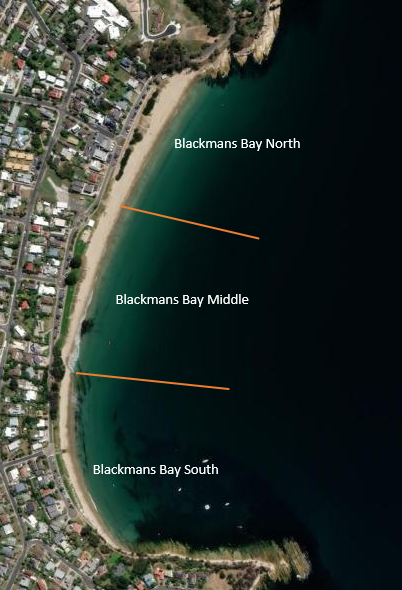 Council is investigating possible sources of water contamination after a series of high sample results during the 2022-23 swimming season.
Council is investigating possible sources of water contamination after a series of high sample results during the 2022-23 swimming season.
Beach Watch Program
Local councils, the Derwent Estuary Program and Environmental Protection Authority collect water samples from 35 sites throughout the Derwent estuary each Tuesday from the start of December to the end of March. This program is called the Beach Watch Program and it has been running for over 20 years.
Blackmans Bay Beach has three regular testing sites which have been broken up into South, Middle and North. (Seen on map on right) The red lines indicated where each section ends and the next begins.
Water Testing & Ratings
Water samples are analysed for specific bacteria (enterococci) which indicate the presence of contaminants from stormwater run-off and other sources. Each site is classified as having Good, Fair or Poor water quality in accordance with state and national guidelines, based on five years of data.
What the gradings mean:
- Good – Water quality is usually good for swimming.
- Fair – Water quality is usually fair for swimming, but occasionally requires re-testing.
- Poor – Swimming is not advised.
Further information and up-to-date data on beach water quality can be found on the Derwent Estuary Program website.
Weekly water testing is continuing over the winter months with Council already taking steps to intensively test and investigate catchments to find any sources of contamination.
This page will be updated regularly, with weekly water testing results for the three sampling sites in Blackmans Bay posted below:
Current Test Results Blackmans Bay Beach
Blackmans Bay Beach Water Quality Winter Testing
| Date | Blackmans Bay North | Blackmans Bay Mid | Blackmans Bay South |
|---|---|---|---|
| 27/04/2023 | Pass | Pass | Pass |
| 2/05/2023 | Pass | Pass | Fail |
| 4/05/2023 | Pass | Pass | Pass |
| 10/05/2023 | Pass | Pass | Pass |
| 11/05/2023 | Pass | Pass | Pass |
| 17/05/2023 | Pass | Pass | Pass |
| 18/05/2023 | Pass | Pass | Pass |
| 23/05/2023 | Pass | Pass | Pass |
| 25/05/2023 | Pass | Pass | Fail |
| 30/05/2023 | Pass | Pass | Pass |
| 01/06/2023 | Pass | Pass | Pass |
| 6/06/2023 | Pass | Pass | Pass |
| 8/06/2023 | Pass | Pass | Pass |
| 13/06/2023 | Pass | Pass | Pass |
| 15/06/2023 | Pass | Pass | Pass |
| 20/06/2023 | Pass | Pass | Pass |
| 22/06/2023 | Pass | Pass | Pass |
| 27/06/2023 | Pass | Pass | Pass |
| 29/06/2023 | Pass | Pass | Pass |
| 4/07/2023 | Pass | Pass | Pass |
| 6/07/2023 | Pass | Pass | Pass |
| 11/07/2023 | Pass | Pass | Pass |
| 13/07/2023 | Pass | Pass | Pass |
| 18/07/2023 | Pass | Pass | Pass |
| 20/07/2023 | Pass | Pass | Pass |
| 25/07/2023 | Pass | Pass | Pass |
| 27/07/2023 | Pass | Pass | Pass |
| 1/08/2023 | Pass | Pass | Pass |
| 3/08/2023 | Pass | Pass | Pass |
| 8/08/2023 | Pass | Pass | Pass |
| 10/08/2023 | Pass | Pass | Pass |
| 15/08/2023 | Pass | Pass | Pass |
| 17/08/2023 | Pass | Pass | Pass |
| 22/08/2023 | Pass | Pass | Pass |
| 24/08/2023 | Pass | Pass | Pass |
| 29/08/2023 | Pass | Pass | Pass |
| 31/08/2023 | Pass | Pass | Pass |
| 5/09/2023 | Pass | Pass | Pass |
| 7/09/2023 | Pass | Pass | Pass |
| 12/09/2023 | Pass | Pass | Pass |
| 14/09/2023 | Pass | Pass | Pass |
| 19/09/2023 | Pass | Pass | Pass |
| 21/09/2023 | Pass | Pass | Pass |
| 26/09/2023 | Pass | Pass | Pass |
| 28/09/2023 | Pass | Pass | Pass |
| 3/10/2023 | Pass | Pass | Fail |
| 5/10/2023 | Pass | Pass | Pass |
| 10/10/2023 | Pass | Pass | Pass |
| 12/10/2023 | Pass | Pass | Fail |
| 17/10/2023 | Pass | Pass | Pass |
| 19/10/2023 | Pass | Pass | Pass |
| 24/10/2023 | Pass | Pass | Pass |
| 31/10/2023 | Pass | Pass | Pass |
| 07/11/2023 | Pass | Pass | Pass |
| 09/11/2023 | Pass | Pass | Fail |
| 14/11/2023 | Pass | Pass | Pass |
| 16/11/2023 | Pass | Pass | Pass |
| 21/11/2023 | Pass | Pass | Pass |
| 23/11/2023 | Pass | Pass | Pass |
| 28/11/2023 | Pass | Pass | Pass |
| 30/11/2023 | Pass | Pass | Fail |
What exactly has been detected in the water?
Enterococci is the indicator used in the summer monitoring program.
Enterococci levels in these samples are measured in cfu/100ml (colony forming units per 100mls).
Enterococci is a faecal bacterium that in indicative of the presence of sewerage but can also be present from other natural sources in the environment such as agricultural runoff, birds and animals.
Water contamination by sewage and animal faeces may pose a health hazard when the water is used for primary contact recreation, such as swimming.
